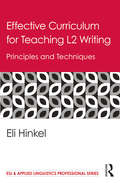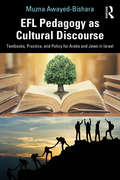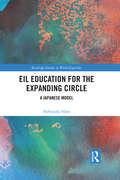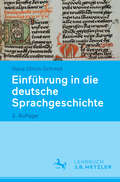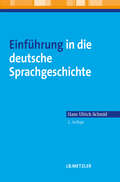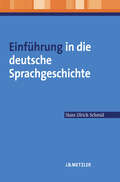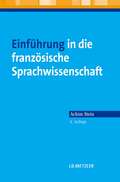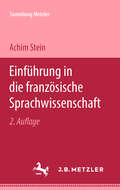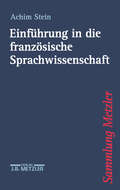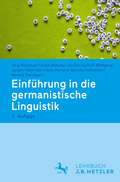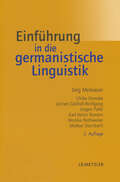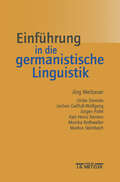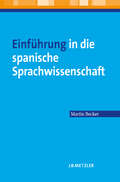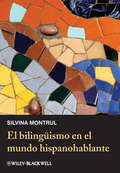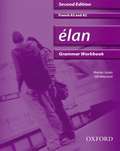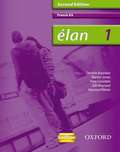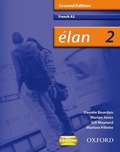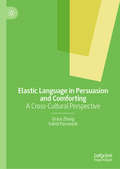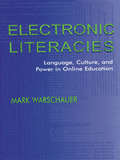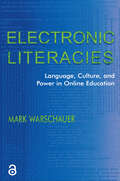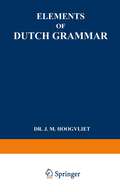- Table View
- List View
Effective Curriculum for Teaching L2 Writing: Principles and Techniques (ESL & Applied Linguistics Professional Series)
by Eli HinkelEffective Curriculum for Teaching L2 Writing sets out a clear big picture for curricular thinking about L2 writing pedagogy and offers a step-by-step guide to curriculum design with practical examples and illustrations. Its main purpose is to help pre-service and practicing teachers design courses for teaching academic writing and to do this as efficiently and effectively as possible. Bringing together the what and the how-to with research-based principles, what sets this book apart is its overarching focus on language pedagogy and language building. Part 1 examines curricular foundations in general and focuses on what is socially valued in L2 writing and pedagogy at school and at the college and university level. Part 2 is concerned with the nitty-gritty̶—the daily realities of curricular design and classroom instruction. Part 3 takes a close look at the key pedagogical ingredients of teaching academic L2 writing: vocabulary and collocations, grammar for academic writing, and down-to-earth techniques for helping L2 writers to organize discourse and ideas. The Appendix provides an extensive checklist for developing curricula for a course or several courses in language teaching.
Effective Curriculum for Teaching L2 Writing: Principles and Techniques (ESL & Applied Linguistics Professional Series)
by Eli HinkelEffective Curriculum for Teaching L2 Writing sets out a clear big picture for curricular thinking about L2 writing pedagogy and offers a step-by-step guide to curriculum design with practical examples and illustrations. Its main purpose is to help pre-service and practicing teachers design courses for teaching academic writing and to do this as efficiently and effectively as possible. Bringing together the what and the how-to with research-based principles, what sets this book apart is its overarching focus on language pedagogy and language building. Part 1 examines curricular foundations in general and focuses on what is socially valued in L2 writing and pedagogy at school and at the college and university level. Part 2 is concerned with the nitty-gritty̶—the daily realities of curricular design and classroom instruction. Part 3 takes a close look at the key pedagogical ingredients of teaching academic L2 writing: vocabulary and collocations, grammar for academic writing, and down-to-earth techniques for helping L2 writers to organize discourse and ideas. The Appendix provides an extensive checklist for developing curricula for a course or several courses in language teaching.
EFL Pedagogy as Cultural Discourse: Textbooks, Practice, and Policy for Arabs and Jews in Israel
by Muzna Awayed-BisharaThis book offers unique insight into the role that English as a Foreign Language (EFL) discourse plays in shaping the ideological terrain of contemporary Israel/Palestine through constructing the subjectivities of those who plan, teach, and learn it. While the EFL curriculum is uniform across Hebrew and Arabic-speaking educational contexts, this book traces how its cultural content reproduces dominant hegemonic ideologies, and perpetuates the social misrepresentations of the Other that underlie inequality. The language of English teaching textbooks, the way that students understand their content, and the official policy documents that guide both EFL materials and teaching practices, are all thoroughly examined through Critical Discourse Analysis. The theoretical and methodological foundation for further cross-cultural studies of Anglo-centric and other forms of hegemonic EFL discourses within local/global contexts, and for contesting their ideological effects, are also laid down. Through promoting a transformative EFL cultural discourse which hopes to position EFL teaching as a possible arena for effecting social change, this book offers a unique context for students, scholars, and educators interested in linguistics, CDA, cultural discourse studies, English in local/global contexts, and EFL education.
EFL Pedagogy as Cultural Discourse: Textbooks, Practice, and Policy for Arabs and Jews in Israel
by Muzna Awayed-BisharaThis book offers unique insight into the role that English as a Foreign Language (EFL) discourse plays in shaping the ideological terrain of contemporary Israel/Palestine through constructing the subjectivities of those who plan, teach, and learn it. While the EFL curriculum is uniform across Hebrew and Arabic-speaking educational contexts, this book traces how its cultural content reproduces dominant hegemonic ideologies, and perpetuates the social misrepresentations of the Other that underlie inequality. The language of English teaching textbooks, the way that students understand their content, and the official policy documents that guide both EFL materials and teaching practices, are all thoroughly examined through Critical Discourse Analysis. The theoretical and methodological foundation for further cross-cultural studies of Anglo-centric and other forms of hegemonic EFL discourses within local/global contexts, and for contesting their ideological effects, are also laid down. Through promoting a transformative EFL cultural discourse which hopes to position EFL teaching as a possible arena for effecting social change, this book offers a unique context for students, scholars, and educators interested in linguistics, CDA, cultural discourse studies, English in local/global contexts, and EFL education.
EIL Education for the Expanding Circle: A Japanese Model (Routledge Studies in World Englishes)
by Nobuyuki HinoThe teaching of English in the Expanding Circle, traditionally called EFL countries, has long been regarded as having no choice but to follow Inner Circle or Anglo-American norms, both in pedagogy and language models. This situation is in sharp contrast with that of the Outer Circle, or ESL countries, where the WE (World Englishes) paradigm, coupled with post-colonialism, has liberated the users of indigenous Englishes from the norms of Anglophone native speakers. Employing. Japan as a primary sample, this book proposes a new paradigm of EIL (English as an International Language) education, by integrating relevant paradigms such as WE and ELF (English as a Lingua Franca), which enables users of English from the Expanding Circle to represent their own voices in international communication.. Various examples of actual classroom practice in EIL are also presented, bridging the longstanding gap between theory and practice in this field.
EIL Education for the Expanding Circle: A Japanese Model (Routledge Studies in World Englishes)
by Nobuyuki HinoThe teaching of English in the Expanding Circle, traditionally called EFL countries, has long been regarded as having no choice but to follow Inner Circle or Anglo-American norms, both in pedagogy and language models. This situation is in sharp contrast with that of the Outer Circle, or ESL countries, where the WE (World Englishes) paradigm, coupled with post-colonialism, has liberated the users of indigenous Englishes from the norms of Anglophone native speakers. Employing. Japan as a primary sample, this book proposes a new paradigm of EIL (English as an International Language) education, by integrating relevant paradigms such as WE and ELF (English as a Lingua Franca), which enables users of English from the Expanding Circle to represent their own voices in international communication.. Various examples of actual classroom practice in EIL are also presented, bridging the longstanding gap between theory and practice in this field.
Einführung in die deutsche Sprachgeschichte
by Hans Ulrich SchmidDiese Einführung bietet einen Überblick über die Entwicklung der deutschen Sprache vom Althochdeutschen bis zum Frühneuhochdeutschen mit Ausblicken auf die jüngere Sprachgeschichte und die Gegenwartssprache. Soweit es für das Verständnis heutiger oder historischer Sprachformen notwendig ist, wird auch das Germanische und Indogermanische einbezogen. Der Autor stellt die Sprachentwicklung auf den verschiedenen Ebenen dar: Laut und Schrift, Bildung von Wörtern und Wortformen, Wortschatz, Syntax und Semantik (Bedeutungswandel). Mit Tabellen (zu Laut- und Flexionsparadigmen) und Überblicksdarstellungen, Abbildungen, Textbeispielen und Analysen sowie vertiefenden Literaturhinweisen. – Für die dritte Auflage wurde der Band durchgesehen, aktualisiert und insbesondere das Kapitel zur Syntax überarbeitet.
Einführung in die deutsche Sprachgeschichte
by Hans Ulrich SchmidDiese Einführung bietet einen Überblick über die Entwicklung der deutschen Sprache vom Althochdeutschen bis zum Frühneuhochdeutschen mit Ausblicken auf die jüngere Sprachgeschichte und die Gegenwartssprache. Der Autor dokumentiert wichtige Sprachstufen anhand zahlreicher Analysebeispiele und stellt die Sprachentwicklung epochenübergreifend auf den verschiedenen Ebenen dar: Laut und Schrift, Wortformen, Satzbau und Wortschatz. Mit Abbildungen und Tabellen (zu Laut- und Flexionsparadigmen) sowie kommentierten Textbeispielen.
Einführung in die deutsche Sprachgeschichte
by Hans Ulrich SchmidÜberblick über die Geschichte der deutschen Sprache vom Althochdeutschen bis zum Frühneuhochdeutschen mit Ausblicken auf die jüngere Sprachgeschichte und die Gegenwartssprache. Der Autor dokumentiert wichtige Sprachstufen anhand zahlreicher Analysebeispiele und stellt die Sprachentwicklung epochenübergreifend auf den verschiedenen Ebenen dar: Laut und Schrift, Wortformen, Satzbau und Wortschatz. Mit kommentierten Textbeispielen, Abbildungen und Tabellen (zu Laut- und Flexionsparadigmen). Optimal für BA-Studiengänge geeignet.
Einführung in die französische Sprachwissenschaft
by Achim SteinZuverlässiges Fundament für das Französischstudium. Ob Phonetik, Syntax, Semantik oder Sprachgeschichte der bewährte Band deckt alle Bereiche der französischen Sprachwissenschaft ab und erläutert die zentralen Grundbegriffe. Weitere Kapitel widmen sich den regionalen und sozialen Varietäten des Französischen sowie Minderheitensprachen und dem Französischen außerhalb Frankreichs. Ein Analyse-Beispiel führt die Anwendung des Gelernten vor. Für die vierte Auflage wurde der Band umfassend überarbeitet und aktualisiert. Erweitert wurden insbesondere die Kapitel zu Sprachverarbeitung, Korpuslinguistik und Sprachwandel. Im zweifarbigen Layout, mit Definitionen, Abbildungen, Grafiken und einem zweisprachigen Sachregister.
Einführung in die französische Sprachwissenschaft (Sammlung Metzler)
by Achim SteinGrundlagen der Französischen Linguistik. In alle für das Französischstudium zentralen Themen, wie z. B. Phonetik, Syntax, Semantik, Sprachgeschichte und Varietäten des Französischen, führt der Autor anschaulich ein.
Einführung in die französische Sprachwissenschaft (Sammlung Metzler)
by Achim SteinDas Buch führt am Beispiel des Französischen in die Grundbegriffe der Linguistik ein.
Einführung in die germanistische Linguistik
by Jörg Meibauer Ulrike Demske Jochen Geilfuß-Wolfgang Jürgen Pafel Karl Heinz Ramers Monika Rothweiler Markus SteinbachDiese Einführung informiert über die linguistischen Kerngebiete Lexikon und Morphologie , Phonologie , Syntax , Semantik und Pragmatik . Sie erläutert Grundbegriffe, illustriert sie an Beispielen aus dem Deutschen und gibt einen Einblick in die linguistische Theoriebildung. Kindlicher Spracherwerb und Sprachwandel - zwei Gebiete, die von großer Bedeutung für ein tieferes Verständnis der menschlichen Sprache sind - werden in weiteren Kapiteln vorgestellt. Mit Übungen, einem Glossar der wichtigsten Fachtermini, einer weiterführenden Schlussbibliographie und einem Sachregister. Für die 3. Auflage wurde der Band umfassend überarbeitet und aktualisiert.
Einführung in die germanistische Linguistik
by Jörg Meibauer Ulrike Demske Jochen Geilfuß-Wolfgang Jürgen Pafel Karl Heinz Ramers Monika Rothweiler Markus SteinbachPflichtlektüre für Studium und Examen. Für jeden Einsteiger gut verständlich vermitteln die Autoren das Grundlagenwissen der fünf linguistischen Kerngebiete Morphologie, Phonologie, Syntax, Semantik und Pragmatik. Ebenfalls im Fokus: die für Prüfungen und das allgemeine Verständnis wichtigen Themen "linguistische Theoriebildung", "Spracherwerb" und "Sprachwandel". Die übersichtliche Gliederung, Glossar, Sachregister und vertiefende Literaturhinweise helfen, sich systematisch einzuarbeiten.
Einführung in die germanistische Linguistik
by Jörg Meibauer Ulrike Demske Jochen Geilfuß-Wolfgang Jürgen Pafel Karl-Heinz Ramers Monika Rothweiler Markus SteinbachDieses Lehrbuch zur germanistischen Linguistik bietet eine moderne Einführung in die Kerngebiete "Lexikon und Morphologie", "Phonologie", "Syntax", "Semantik" und "Pragmatik". Zwei weitere Kapitel sind dem kindlichen Spracherwerb und dem Sprachwandel gewidmet. Allen Kapiteln sind Übungen begegeben.
Einführung in die spanische Sprachwissenschaft
by Martin Becker¿Habla usted español? Auf den Spuren einer Weltsprache. Die Einführung vermittelt die Grundlagen der spanischen Sprachwissenschaft von der Phonetik, Morphologie über Syntax und Semantik bis zur Text- und Korpuslinguistik. Mit der Vielfalt des Spanischen beschäftigt sich die Varietätenlinguistik: mit den Regionalsprachen auf der iberischen Halbinsel, dem Spanischen in Lateinamerika und in den USA. Der sprachgeschichtliche Teil kümmert sich um das Gestern und Heute; es geht unter anderem um die Herausbildung des Spanischen und um Sprachwandelphänomene.
El bilingüismo en el mundo hispanohablante
by Silvina MontrulEsta amplia introducción al bilingüismo en español abarca los contextos sociales, políticos y culturales del español en EEUU, España y Hispanoamérica. Escrito para estudiantes no nativos de español, es el primer libro de texto de estas características para los estudiantes de lingüística hispánica. Este libro de texto en español presenta los temas fundamentales en el estudio del bilingüismo a estudiantes y profesionales Explora comunidades bilingües en Estados Unidos, Hispanoamérica y España Crea conciencia crítica sobre la complejidad del bilingüismo como un fenómeno sociopolítico y cultural Se organiza en tres secciones principales centradas en la sociedad y el individuo: el bilingüismo y la sociedad; el bilingüismo y el individuo; y la política y la educación Incluye mapas, recuadros de resumen del capítulo, vocabulario y conceptos clave y preguntas de comprensión, así como preguntas para reflexionar, investigar y comentar al final de cada capítulo This wide-ranging introduction to Spanish bilingualism covers the social, political, and cultural contexts of Spanish in the US, Spain, and Hispanoamérica. Written for non-native Spanish learners, it offers the first textbook of its kind for students of Hispanic linguistics. This Spanish-language textbook introduces students and professionals to the fundamental issues in the study of bilingualism Explores bilingual communities in the United States, Hispanoamérica, and Spain Raises critical awareness of the complexity of bilingualism as a sociopolitical and cultural phenomenon Organized in three main sections which focus on both society and the individual: bilingualism and society; bilingualism and the individual; and politics and education Includes maps, chapter summary boxes, key terms and concepts, and comprehension questions, as well as questions for reflection, research and discussion at the end of each chapter
El bilingüismo en el mundo hispanohablante
by Silvina MontrulEsta amplia introducción al bilingüismo en español abarca los contextos sociales, políticos y culturales del español en EEUU, España y Hispanoamérica. Escrito para estudiantes no nativos de español, es el primer libro de texto de estas características para los estudiantes de lingüística hispánica. Este libro de texto en español presenta los temas fundamentales en el estudio del bilingüismo a estudiantes y profesionales Explora comunidades bilingües en Estados Unidos, Hispanoamérica y España Crea conciencia crítica sobre la complejidad del bilingüismo como un fenómeno sociopolítico y cultural Se organiza en tres secciones principales centradas en la sociedad y el individuo: el bilingüismo y la sociedad; el bilingüismo y el individuo; y la política y la educación Incluye mapas, recuadros de resumen del capítulo, vocabulario y conceptos clave y preguntas de comprensión, así como preguntas para reflexionar, investigar y comentar al final de cada capítulo This wide-ranging introduction to Spanish bilingualism covers the social, political, and cultural contexts of Spanish in the US, Spain, and Hispanoamérica. Written for non-native Spanish learners, it offers the first textbook of its kind for students of Hispanic linguistics. This Spanish-language textbook introduces students and professionals to the fundamental issues in the study of bilingualism Explores bilingual communities in the United States, Hispanoamérica, and Spain Raises critical awareness of the complexity of bilingualism as a sociopolitical and cultural phenomenon Organized in three main sections which focus on both society and the individual: bilingualism and society; bilingualism and the individual; and politics and education Includes maps, chapter summary boxes, key terms and concepts, and comprehension questions, as well as questions for reflection, research and discussion at the end of each chapter
Élan: Grammar Workbook (PDF)
by Marian Jones Gill MaynardThis text is intended for AS or A2 students of all abilities, as a practical introduction to French grammar. This new 2008 edition of this popular course has been fully revised to support the new specifications. This Grammar Workbook is ideal for improving students' listening and speaking skills and contains a variety of authentic listening activities, including interviews, reports, dialogues, and discussions.
Élan 1: student book (PDF)
by Marian Jones Martine Pillette Daniele Bourdais Gill MaynardThis text is intended for AS or A2 students of all abilities, as a practical introduction to French grammar.nbsp; This new 2008 edition of this popular course has been fully revised to support the new specifications. It includes engaging bridging material at AS Level to keep students motivated and learning with topics that interest them, plus updated content to deliver the specification easily and effectively.
Elan 2: Student Book (PDF)
by Danièle Bourdais Marian Jones Martine Pillette Gill MaynardThe second stage of a two-part French course written to match the AQA AS and A2 specifications. The nine teaching units are sequenced to resource these specifications, but coverage and activities are also suitable for other specifications. There is also an essay-writing and coursework section.
Elastic Language in Persuasion and Comforting: A Cross-Cultural Perspective
by Grace Zhang Vahid ParvareshThis innovative book examines the discourse of reality television, and the elasticity of language in the popular talent show The Voice from a cross-cultural perspective. Analysing how and why elastic language is used in persuasion and comforting, a comparison between Chinese and English is made, and the authors highlight the special role that elastic language plays in effective interactions and strategic communication. Through the lens of the language variance of two of the world’s most commonly spoken languages, the insights and resources provided by this book are expected to advance knowledge in the fields of contrastive pragmatics and cross-cultural communication, and inform strategies in bridging different cultures. This study highlights the need to give the elastic use of language the attention it deserves, and reveals how language is non-discrete and strategically stretchable. This book will be of interest to academics and postgraduate students engaged in elastic/vague language studies, cross-cultural pragmatics, media linguistics, discourse analysis, sociolinguistics and communication studies.
Electronic Literacies: Language, Culture, and Power in Online Education
by Mark WarschauerElectronic Literacies is an insightful study of the challenges and contradictions that arise as culturally and linguistically diverse learners engage in new language and literacy practices in online environments. The role of the Internet in changing literacy and education has been a topic of much speculation, but very little concrete research. This book is one of the first attempts to document the role of the Internet and other new digital technologies in the development of language and literacy. Warschauer looks at how the nature of reading and writing is changing, and how those changes are being addressed in the classroom. His focus is on the experiences of culturally and linguistically diverse learners who are at special risk of being marginalized from the information society. Based on a two-year ethnographic study of the uses of the Internet in four language and writing classrooms in the state of Hawai'i--a Hawaiian language class of Native Hawaiian students seeking to revitalize their language and culture; an ESL class of students from Pacific Island and Latin American countries; an ESL class of students from Asian countries; and an English composition class of working-class students from diverse ethnic backgrounds--the book includes data from interviews with students and teachers, classroom observations, and analysis of student texts. This rich ethnographic data is combined with theories from a broad range of disciplines to develop conclusions about the relationship of technology to language, literacy, education, and culture. Central to Warschauer's discussion and conclusions is how contradictions of language, culture, and class affect the impact of Internet-based education. While Hawai'i is a special place, the issues confronted here are similar in many ways to those that exist throughout the United States and many other countries: How to provide culturally and linguistically diverse students traditionally on the educational and technological margins with the literacies they need to fully participate in public, community, and economic life in the 21st century.
Electronic Literacies: Language, Culture, and Power in Online Education
by Mark WarschauerElectronic Literacies is an insightful study of the challenges and contradictions that arise as culturally and linguistically diverse learners engage in new language and literacy practices in online environments. The role of the Internet in changing literacy and education has been a topic of much speculation, but very little concrete research. This book is one of the first attempts to document the role of the Internet and other new digital technologies in the development of language and literacy. Warschauer looks at how the nature of reading and writing is changing, and how those changes are being addressed in the classroom. His focus is on the experiences of culturally and linguistically diverse learners who are at special risk of being marginalized from the information society. Based on a two-year ethnographic study of the uses of the Internet in four language and writing classrooms in the state of Hawai'i--a Hawaiian language class of Native Hawaiian students seeking to revitalize their language and culture; an ESL class of students from Pacific Island and Latin American countries; an ESL class of students from Asian countries; and an English composition class of working-class students from diverse ethnic backgrounds--the book includes data from interviews with students and teachers, classroom observations, and analysis of student texts. This rich ethnographic data is combined with theories from a broad range of disciplines to develop conclusions about the relationship of technology to language, literacy, education, and culture. Central to Warschauer's discussion and conclusions is how contradictions of language, culture, and class affect the impact of Internet-based education. While Hawai'i is a special place, the issues confronted here are similar in many ways to those that exist throughout the United States and many other countries: How to provide culturally and linguistically diverse students traditionally on the educational and technological margins with the literacies they need to fully participate in public, community, and economic life in the 21st century.
